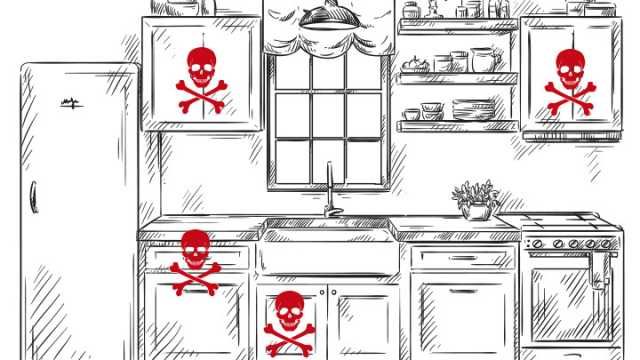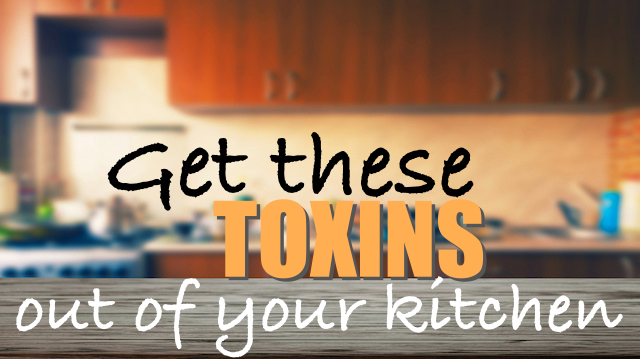
Eating good quality food is one of the most important things we can do for our health, but it can really add up in cost. Unfortunately, many of us spend extra money to eat healthy food but don’t realize that we are still cooking and packaging it with toxic equipment.
This could be a grave mistake, with the benefits of all that good food being negated by the use of dangerous kitchen gear. It’s like moving one step forward, only to go two steps back.
With 1,500 new chemicals added into consumer markets on a yearly basis, it’s no wonder that testing is often lacking, and potentially dangerous products make their way into our homes.
We want to ensure that the investment made in organic produce and consciously-sourced animal foods is really going to deliver maximum benefits. Let’s investigate some of the common kitchen paraphernalia that might be contaminating your food.
Plastics — beyond BPA
Most of us know about the dangers of bisphenol-A or BPA, the most notorious plastic toxin. It was recently banned from products geared toward babies and young children due to its hormone-disrupting properties.
However, buying a BPA-free water bottle doesn’t mean that you’re safe. Unfortunately, even plastics marked “BPA free” have been shown to leach chemicals into food and beverages. The BPA has been replaced by different constituents like BPS and BPF, which are variations on the same chemical. While these compounds aren’t under the spotlight, reports indicate they are just as dangerous.
This is a good reason to avoid buying plastic-packaged products entirely, or at the very least, avoid putting any plastic containers in the microwave or dishwasher. Also, be aware that most cans are lined with BPA. This is particularly a problem with acidic foods, such as canned tomatoes or citrus slices. Opt for fresh foods whenever possible, or seek out brands that use BPA-free cans for essentials like coconut milk and canned salmon.
Avoid other plastic items such as steaming or cooking bags, cutting boards and cooking utensils. The cheap plastic spatulas and slotted spoons found in many of our kitchen drawers are usually contaminated with brominated fire retardants, which are known to cause cancer and birth defects. These chemical-ridden items slip through the regulatory net because manufacturers use recycled plastics to save costs.
Melamine is another common plastic which is best avoided. Those hard plastic dishes are known to leach formaldehyde, which is a core component in their manufacture.
Plastic cutting boards tend to wear down and contribute small bits of plastic to our food. Opt for wood or bamboo instead. These natural cutting board materials can be easily cleaned, deodorized and sanitized by scrubbing with some lemon juice and salt.
Furthermore, plastic is terrible for the planet. Just one more reason to go plastic-free!
Nonstick pans
While nonstick cookware is the pinnacle of convenience, it’s not worth the toxic trade-off. The Teflon coating is made with a carcinogenic chemical called PFOA (perfluorooctanoic acid) which can emit fumes when heated. The coating is also notorious for flaking and peeling off over time; this is definitely something you do not want to consume.
While anodized aluminum pans are a commonly recommended alternative, the anodized coating can also break down over time and leach chemicals. The best choices are cast iron, high-quality ceramic, and glass, which last forever and are definitely safe.
Aluminum and stainless steel
While these metals are often considered safe and inert, there are actually a few concerns to take into consideration.
Aluminum is a soft metal which has been linked to brain disorders. Studies have found that measurable amounts can leach into food when it is used for cooking.
Stainless steel on the other hand is often considered safe, but long-term use can lead to scratches which cause nickel and chromium to get into your food. For that reason, abrasive cleaners should not be used on stainless steel. In addition, stick with high-quality, food-grade stainless steel labeled with the code “304.”
Silicone
That bendy and colorful material has become ubiquitous in kitchens in recent years, partially because we consider it to be nontoxic. However, some studies indicate it may leach chemicals at extreme temperatures, such as when used for baking or when frozen.
Most sources maintain that high-quality, food-grade silicone is still safe, but ultimately this material is a man-made polymer (plastic) which is manufactured from 30 to 40 different chemical ingredients.
To be safe, we recommend food-grade silicone with no fillers only for storage or utensils. Stick with unbleached parchment paper for baking, or natural rubber for freezing (such as baby teething items). Stainless steel is a safer choice for other frozen items such as ice-cube trays.
Cleaning products
Cleaning solutions are another common “disconnect” in healthy living circles. Many of us will fork out for organic veggies yet still rely on the name-brand cleaners we are used to, probably for no other reason than the fact that we grew up with them. We associate their perfumey scents with cleanliness and don’t believe that surfaces are properly sanitized unless we’ve used the stuff that “kills 99.99% of germs.”
Unfortunately commercial cleaning products contain a laundry list of worrisome chemicals:
- Triclosan: an antibacterial agent that harms the immune system and pollutes waterways
- Pthalates: compounds which reduce sperm counts and disrupt hormones
- Perchloroethylene: a known neurotoxin and possible carcinogen
- Quaternary ammonium compounds: these are suspected to contribute to respiratory disorders and skin irritation
- 2-Butoxyethanol: a chemical which gives cleaners their sweet smell, but contributes to organ damage
- Ammonia: it doesn’t leave streaks on windows, but it can leave you with chronic bronchitis or asthma
Clearly it’s not worth the risk of subjecting ourselves and our families to these dangerous chemicals. Even worse, harsh chemical cleaners and abrasives cause dishes and cooking utensils to break down faster encouraging the leaching of chemicals.
So what’s the safe alternative? Try making your own cleaning solutions with ingredients like vinegar, lemon juice, castile soap, baking soda and essential oils. You’ll be surprised how many of the toxic products in your cupboard can be swapped out with simple, nontoxic replacements that are cheap and easy to make!
Bleached paper products
 Those nice white paper towels, baking cups and parchment paper may look pretty, but they are a hotbed for toxic chemicals. The same goes for tea bags, coffee filters and cleaning wipes.
Those nice white paper towels, baking cups and parchment paper may look pretty, but they are a hotbed for toxic chemicals. The same goes for tea bags, coffee filters and cleaning wipes.
Paper is bleached with chlorine, which creates a chemical byproduct called dioxin. Dioxin is considered cancer-promoting and causes adverse effects on the endocrine and immune systems. It also damages fertility. These effects are particularly worrying for babies and children since their organs and tissues are developing rapidly.
An easy solution is to buy unbleached versions of your usual products. Go one step further by committing to reusable alternatives rather than continuing to use disposable products. Some examples include washable bamboo kitchen towels, reusable tea filters and a French press for coffee.
A few simple steps can change your kitchen from a toxic soup to a safe space, clean and green!
—The Alternative Daily
Sources:
http://www.nature.com/nature/journal/v401/n6755/abs/401763a0.html
http://archsurg.jamanetwork.com/article.aspx?articleid=557022
http://www.researchgate.net/profile/Myriam_Gharbi/publication/44686685_Polybrominated_Diphenyl_Ether_(PBDE)_Flame_Retardants_and_Thyroid_Hormone_during_Pregnancy/links/0fcfd5146fd56292eb000000.pdf
http://www.sciencedirect.com/science/article/pii/S004896970100852X
http://www.scientificamerican.com/article/earth-talk-silicone-tally
http://www.ewg.org/guides/cleaners/content/cleaners_and_health

